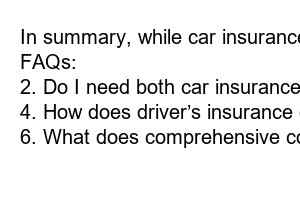자동차보험 운전자보험 차이
Title: The Distinction Between Car Insurance and Driver’s Insurance Explained
Introduction:
When it comes to protecting your vehicle and yourself on the road, understanding the differences between car insurance and driver’s insurance is crucial. While both serve to safeguard you, your vehicle, and others on the road, they have distinct purposes and coverages. In this article, we will delve deeper into the disparities between these two types of insurance and provide you with a comprehensive understanding.
1. Car Insurance:
Car insurance primarily focuses on protecting your vehicle against damages resulting from accidents, theft, natural disasters, and other unforeseen events. It ensures that you have financial support for repairs, replacements, or even medical expenses associated with a vehicular incident, depending on your policy.
2. Driver’s Insurance:
On the other hand, driver’s insurance is centered around protecting the individual behind the wheel. It primarily covers bodily injury liability, which includes medical expenses, lost wages, and legal fees resulting from injuries to another person in an accident where the insured driver is at fault.
3. Coverage Scope:
Car insurance covers the vehicle itself, including the cost of repairs or replacement, while driver’s insurance caters to the individual driver and their liability in accidents. It is essential to have both types of insurance to ensure comprehensive protection on the road.
4. Car Insurance Limitations:
Car insurance may have limitations based on the type of coverage you choose. For instance, collision coverage may not cover damage caused by a natural disaster. It is crucial to review your policy carefully to understand its limitations and additional coverage options that may be necessary for your specific needs.
5. Driver’s Insurance Limitations:
Driver’s insurance, or personal injury protection (PIP), might have certain limitations concerning the extent of coverage for medical expenses or lost wages. It’s important to understand the maximum limits and any exclusions to prepare for any unforeseen situations effectively.
6. Legal Requirements:
While car insurance is mandatory in most states, driver’s insurance requirements may vary. Some states have no-fault insurance systems, requiring drivers to carry personal injury protection coverage, while others have different minimum coverage requirements. Familiarize yourself with your state’s regulations to ensure compliance.
7. Determining the Right Coverage:
To determine the right coverage for your needs, evaluate your driving habits, vehicle value, personal financial situation, and state requirements. Discuss your options with a reputable insurance agent who can guide you in selecting the appropriate coverage that meets your budget.
Summary:
In summary, while car insurance focuses on protecting your vehicle from various damages, driver’s insurance centers around the individual driver and their liability in the event of an accident. Both types of insurance fulfill distinct roles in safeguarding you and your vehicle. Understanding the disparities between car insurance and driver’s insurance empowers you to make informed decisions and build a comprehensive insurance coverage plan.
FAQs:
1. Can I acquire car insurance without driver’s insurance?
2. Do I need both car insurance and driver’s insurance?
3. What factors affect car insurance premiums?
4. How does driver’s insurance differ from liability insurance?
5. Does driver’s insurance cover me if I am not at fault in an accident?
6. What does comprehensive coverage typically include in car insurance policies?

